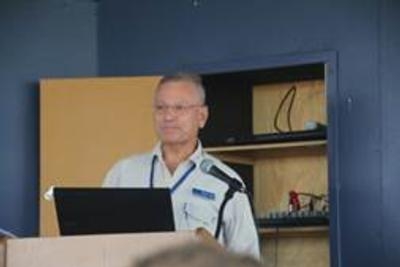Expert Aviation Attorneys Discuss Maintenance And Its Legal Perils
One of the great things about being at AirVenture is that there a countless presenters who are experts in their field and they are more than willing to share their knowledge with all. Two of these experts, Mike Pangia (Washington, DC) and Pat Phillips (Orlando, FL) are experienced aviation attorneys as well as holding ATP and A&P ratings and are on EAA Legal Advisory Council. They are not “ivory tower” guys but “hands on” aviation participants. They gave an excellent presentation on Tuesday, as they do at every Air Venture, regarding some of the legal areas that affect every aviation maintenance technician (AMT).

A recurring problem in aviation is interpretation of FARs; e.g., what exactly does an FAR mean. Is it to be interpreted literally or does one apply common sense? When the FARs allow an IA or A&P to have another person to work under them, what is required of an IA and A&P? Does the IA have to literally see all the work that is done by a helper? What if inspection panels are replaced before the IA can see it? Can the IA take the word of the helper? Does the IA/A&P have to physically see the helper torquing a bolt? What about gapping a spark plug? These are all very difficult questions that are normally raised for one of three reasons: there has been an accident/incident; someone has complained to the FAA or the FAA decides to audit the IA/A&P or his/her shop. The only answer that is always 100% correct is for the IA to physically inspect everything the helper does.
When a IA/A&P returns an airplane to service, he/she is certifying that the airplane is airworthy. What is airworthy? 14 CFR § 3.5 states “Airworthy means the aircraft conforms to its type design and is in a condition for safe operation”. The rub is, what does safe operation mean? What additional duty does it impose on the AMT? An airplane can technically comply with its type certificate, including STCs, but not be safe to fly. How is this? As was explained during the presentation an excellent example is multiple STCs.
We all know that STCs are allowed on aircraft but many don’t realize that STCs are not necessarily tested with other STCs installed on the same aircraft type. This can result in unintended consequences that can be disastrous. An example of this potential is an airplane with multiple STCs that boost engine power. What if one STC on the carburetor boost the power by 20 horsepower, a different propeller gains an additional 10 hp, a different exhaust gets another 10 hp, and bigger cylinders get another 20 hp. Individually, the engine, airframe and propeller could handle the STCs increase in horsepower but the aggregate horsepower increase may exceed the structural strength of the crankshaft, airframe or propeller.

One example of cumulative STCs that resulted in a tragedy was a Cessna 337 that had multiple STCs installed on its wings. The airplane was “legal” re. conforming to its TC but the cumulative effects resulted in wing failure.
This begs the question, since an IA/A&P mechanic certifies the airplane to be airworthy on its return to service, would the mechanic who installed the last STC before a catastrophic failure resulting from multiple STCs being applied to an aircraft be liable, either administratively or is a tort action. Something to think about.
Other issues discussed were the when mandatory service bulletins must be accomplished, fraudulently signing logbooks, preventive maintenance, conditional inspections, and annual inspections, and what are the consequences to the AMT who is involved in any of these activities.
Seminars of this extremely high quality are just another reason to come to AirVenture. As my father used to say, “if it only saves your life once, it is worth it."
(Staff photos: Top, Mike Pangia. Bottom Pat Phillips)
 ANN's Daily Aero-Term (04.20.24): Light Gun
ANN's Daily Aero-Term (04.20.24): Light Gun Aero-News: Quote of the Day (04.20.24)
Aero-News: Quote of the Day (04.20.24) ANN's Daily Aero-Linx (04.21.24)
ANN's Daily Aero-Linx (04.21.24) Aero-News: Quote of the Day (04.21.24)
Aero-News: Quote of the Day (04.21.24) ANN's Daily Aero-Term (04.21.24): Aircraft Conflict
ANN's Daily Aero-Term (04.21.24): Aircraft Conflict




